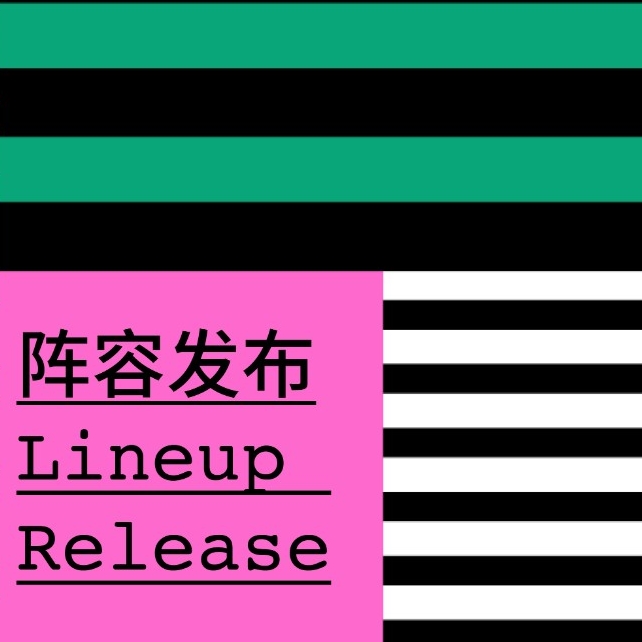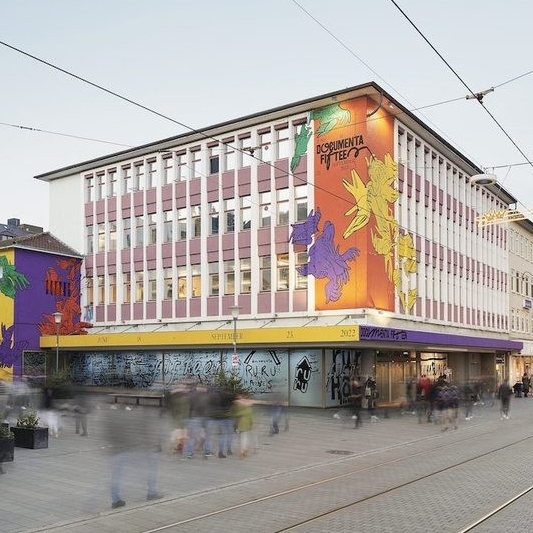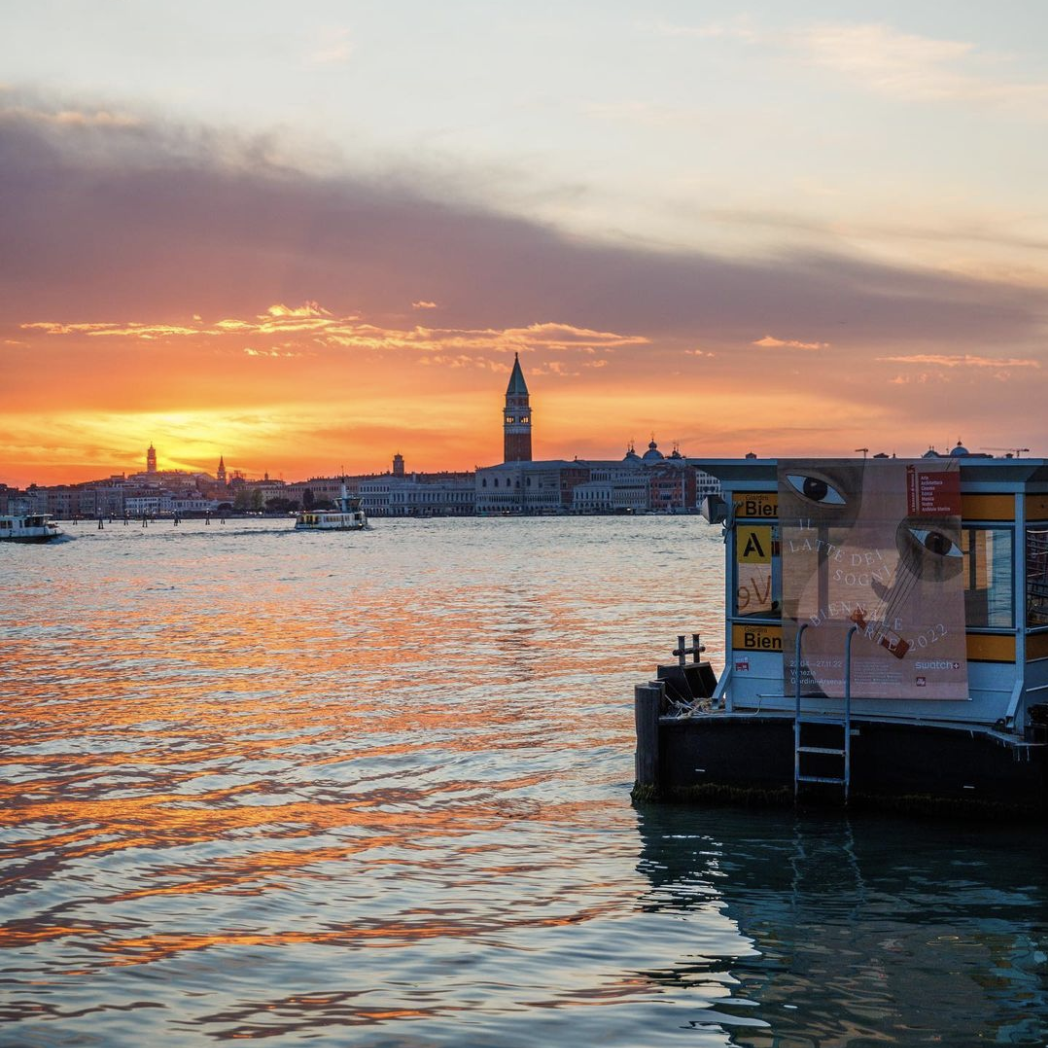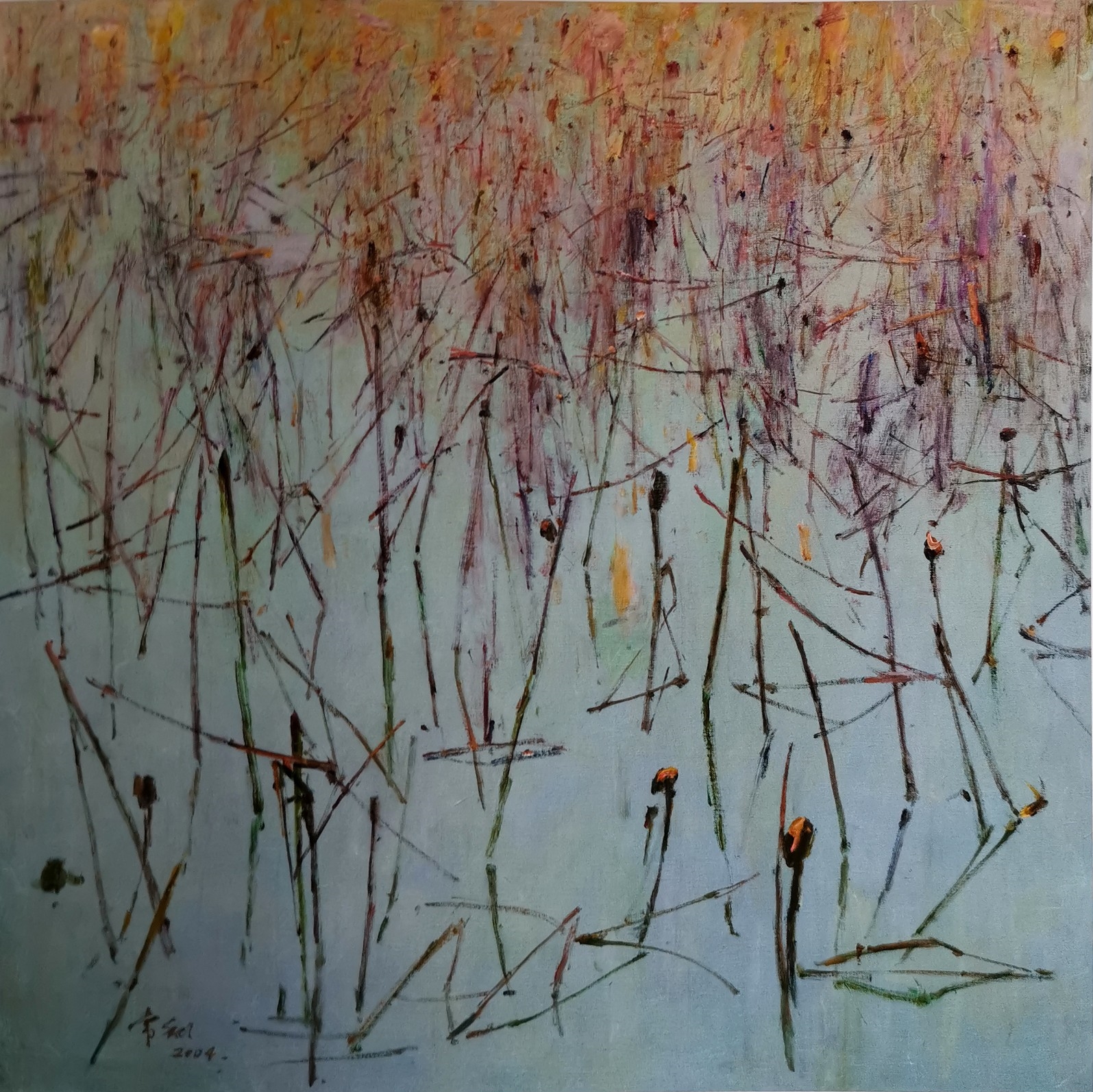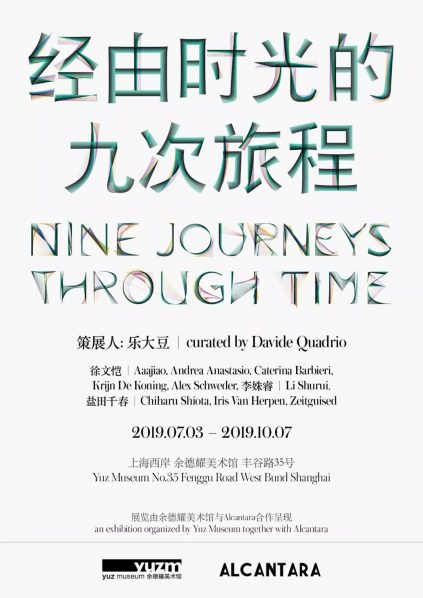
The microscopic reality placed before us by Aaajiao, the zoomorphic geometries of Iris van Herpen. The world altered by the mysterious chimera of Andrea Anastasio and the thick spider webs of Chiharu Shiota. Zeitguised’s digital anamorphosis, the electronic universe of Caterina Barbieri and her synthesiser. The time in the fourth dimension, one beyond our experience and comprehension, as evoked by Li Shurui. The spatial and temporal references of the architecture enveloping the exhibition and which vanish in the room of Krijn de Koning but also the ephemeral performative space by Alex Schweder that envelops the viewer into a soft hug of intimacy and entrapment.
“Nine Journeys Through Time” is an exhibition organized by Yuz Museum together with Alcantara, and evolves from the eponymous show previously presented in the Apartment of the Prince, Royal Palace in Milan, conceived and co-curated by Davide Quadrio and Massimo Torrigiani in 2018. "Nine Journeys Through Time" will open from 3rd July to 7th October, 2019. On the opening day (2nd July), Yuz Museum will not open to the public.
“Nine Journeys Through Time” offers an exceptional combination of talents, 9 artistic approaches are brought together, expressing their visions through 9 projects in various artistic languages. From the transfiguration of painting into fashion, from digital design to music, they all draw inspiration from the specifics of a unique medium: Alcantara, analyzing all its various declinations and potential, exploring its invention and production processes, working with technicians and experts, be it along independent paths or through innovative collaboration projects.
The 9 artists are: Aaajiao, Andrea Anastasio, Caterina Barbieri, Krijn de Koning, Li Shurui, Alex Schweder, Chiharu Shiota, Iris van Herpen, and Zeitguised.
Each of them has come up with a site-specific work, initially dialoguing with the Royal Palace in Milan, itself a setting charged with great creative energy: a launch pad for journeys ranging from anomalous science laboratories, anacondas, mutations, sinusoids, oracular apparitions, twisting from the natural to the artificial and back again, psychedelic corridors and quirky metronomes. All this energy is mutated and transformed in the main exhibition hall of Yuz Museum in Shanghai.
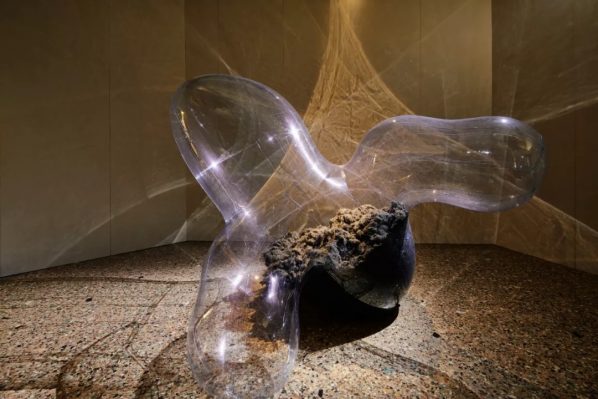
Aaajiao
Desire
Mixed media
150 × 150 × H150 cm
2018
Yuz Museum's “Nine Journeys Through Time” is a development and includes new configurations of the works by Krijn De Koning, Chiharu Shiota and Aaajiao and introduces a new artist into the exhibition: Alex Schweder, an artist based in New York who adds a performative element into the dynamic of the show.
In this process of “moving” the show from Milan to Shanghai, all the precedent stories and complex interactions between the Apartment of the Prince and the artworks, will be narrated in a suspended time and space of an open space.
The big thread that keep the works together is first of all ‘time’ as it is the result of the dialogue between artists and material, artists and places, artists and curators. In this case, the original effect that Apartment of the Prince created, led the artists to a reflection on the various dimensions of time: on ‘our’ time, the everyday, practical and brief dimension, opposed (or complementary) to ‘scientific time’, dilated and imperceptible. Yuz Museum’s experience will add to that a strong feeling of space and architecture where the connections between the artworks and the art pieces will be highly performative and interactive, leaving to the public the pleasure of experiencing all the above in a very ludic and profound way. The work of Alex Schweder both spatial and performative surely will add into this scheme of the curatorial change in perspective. When the artworks are separated from the context they initiated, and entering the soaring museum great hall reconstructed on an old hangar, with white walls and gray flooring, the minimalist and open exhibition design will focus on the artworks themselves, opening up a new dialogue with time and space.
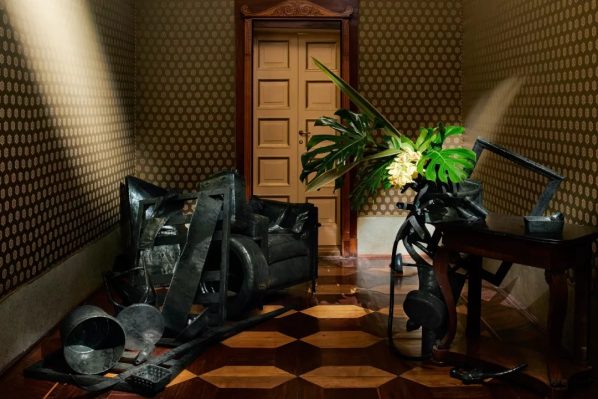
Andrea Anastasio
Eden
Furniture、plant
400 × 400 × H150 cm
2018
Along with the theme of time and thank to the shift of space and time (Milan versus Shanghai, time versus architecture), various perspectives emerge in the exhibition showing the relationship between natural and artificial, between products and nature, between us humans and that which is different from us. This is what gives that ‘research center’ feel to it all. This exhibition not only aims at how artists explore and cross the boundaries of art, but also allows spectators to keep thinking about the factors that influence the artists’ creations. Additionally, more questions will arise such as how cross-disciplinary cooperation is expanding the possibilities of artistic creation, and what does the most authentic art look like.
“Nine Journeys Through Time” is designed to provide an experiential journey, one to be undertaken by spirits willing to let themselves be enveloped in a sense of wonder. Each setting turns out to be a surprise that projects us into a sequence of diverse and enthralling space-time dimensions. A sophisticated experience, at times abstract yet never out of reach, which buffers us between changing worlds and startling aesthetic experiences.
Yuz Museum has always adhered to the founding tenet of “leading the world’s attention to Shanghai”; opening a window to the world for Chinese audiences and bridging the distance between distinct cultures and individuals. Simultaneously, the museum seeks to take advantage of various materials, media, and technology to extend the potential of art in the era of mechanical reproduction, explore the new possibilities of art as a result of modern science and modern practice, and blend into the lives of visitors through diverse interpretations. We are pleased to continue the museum’s curatorial concept through this exhibition and to provide a rich and artistic journey to the audience through interactive artworks by nine different artists.
——Justine Alexandria, Yuz Museum Acting CEO
We are very pleased to present this exhibition in a new configuration from the Royal Palace in Milan to the prestigious Yuz Museum in Shanghai. It is a true example of the strong Alcantara’s belief in the mutual exchange and contamination between Western and Eastern culture, in particular in the world of contemporary Art. This project clearly reaffirms our values and identity through a series of collaborations developing a unique approach with the world of art and building a genuine dialogue with artists, curators, museums and cultural institutions throughout the world.”
——Andrea Boragno, Chairman and CEO of Alcantara S.p.A
THE EXHIBITION CONFIGURATION
For the show in Yuz Museum, the works will not be divided into rooms but will be sharing the same lofty space of the great hall of the museum. The artworks will be just in front of the eyes of the public creating among themselves interactions and layered meanings and connections. Only two works (by artist Andrea Anastasio and artist/designer Iris Van Herpen) will be enclosed into a sacred space, a temple or a spiritual room. So the works not necessarily in the order written here can be experienced by the visitors freely.
Desire by Aaajiao pushes the visitors into a clinical and microscopic spatial dimension, coming face to face with the fundamental unity of this extraordinary material. The time of its coming into being. Several large transparent organic-shaped capsules withhold a body with blurred edges to it, the initial phase of the production process of the eponymous material.
Iris van Herpen: Extended Indefinitely. A sculpture-garment, created through a painstaking crafts process applied to Alcantara material seems to place the visitor before the simulacrum of an unknown civilization, one from the future or some long forgotten era. The garment, a phantasmagorical presence, comes to life, reaching out into all directions in a dark setting.
Andrea Anastasio: Eden. Inspired by a giant anaconda, a metaphor for consumption society, gobbling up everything in its path, the work is presented as a synthesis of elements of industrial production, interspersed with splendid floral elements. The visitor is led along a path through a landscape of urban furnishings, ennobled and transformed into living matter by a luxurious yet unsettling ‘skin’ – a python that has shed its skin, its scales all shiny. Objects common to every living creature today, both human and not. The omnivorous quality of luxury.
The dream of Chiharu Shiota: Reflection of Space and Time. Conceived as a universal place that preserves the memories of humanity, a thick monochromatic spider web – the distinctive sign of the production of the artist, which here uses 110 kilometres of thread of this unusual material applied during the installation stage – crosses and envelops an internal structure from which three iconic chairs stand out. Their image is reflected and multiplied in the mirrors positioned in the centre of the structure, altering the physical and temporal perception of the surrounding space, in a continuous toing and froing of views and illusions, of awakeness and dreaming.
Beyond the Nuclear Garden by the Berlin group Zeitguised. The work is the upshot of an algorithm developed especially for the occasion and that creates a pair of chairs/objects which stand in front of a screen where material’s textures are played around in a magical choreography. The work by Caterina Barbieri is a soundscape that enhance the sacrality of the two rooms occupied by Andrea Anastasio and Iris van Herpen. Her love for digital and analogical textures of sounds well reflects on the nature of the two installations. The same love which is also reflected in her meticulous research into the synthetic nature of sound. Barbieri processed a series of environmental recordings carried out in their production plant to create a soundtrack. This all makes us call into question the relationship between the human and the mechanical, the natural and the artificial, listening and sound. Rhythm is nothing if not the idea reproduction of the natural movement of life.
A large temple with a complex curved structure is the work by artist Li Shurui. Coated in Alcantara printed with the optical motifs that characterize the pictorial production of the artist, the Temple of Reverence for Knowledge Beyond Human Comprehension was designed in order for us to humbly entreat the fourth dimension and all those realms of existence beyond our knowledge and experience. So to assist us, by any possible means, in accepting our three-dimensional, linear and time-restrained clumsiness, and in expanding our consciousness.
The work Room by Krijn de Koning, with an operation of spatial estrangement which leads the visitors into a chamber entirely coated in various colours of the iconic material, of which the edges of the architectural spaces – doors, windows, passageways and geometric chambers – are superimposed onto the real space, thus creating a fictitious perception of time and space.
Alex Schweder’s new addition to the exhibition is called to Sofa to Bed to and offers the gift of respite to exhibitiongoers. Two at a time, each reclines on a furry sofa-like form. Shortly after their heads hit the pillows, air begins to fill the soft suede-like surface they walked upon to reach the center. A sparkling version of the extraordinary material continues to engorge; the sofas and their supine guests slowly rotate toward each other. Full now, the inflated forms have turned the backs of the sofas to form a momentary bed where strangers face one another intimately. Exhaling begets the end of this short closeness. Rotating in silence, returning to two, this space’s shimmering yawn beckons two more into its embrace.
About Yuz Museum Shanghai
Yuz Museum Shanghai, officially opened in May 2014, is a contemporary art museum founded by Mr. Budi Tek, a Chinese-Indonesian entrepreneur, philanthropist and collector. The museum is located in the core area of West Bund Shanghai, and plays an important role in “West Bund Culture Corridor”. Yuz Museum is committed to drawing the world’s attention to Shanghai, advancing the development of contemporary Chinese art, actively in the field of art education, and promoting cultural dialogues between the East and the West. As a non-profit institution, Yuz Museum aims to establish itself as a new landmark for exhibiting contemporary Chinese art and to be a preeminent contemporary art museum in the world.
Designed by acclaimed Japanese Architect, Sou Fujimoto, the museum was renovated from an old aircraft hangar site of the former Shanghai Aircraft Manufacturing Factory. The museum has a total area of 9,000 square meters, among which the hangar-converted great hall alone covers over 3,000 square meters, complementing the numerous large-scale art installations, while the other galleries offer more than 1,000 square meters for paintings, sculptures and photography of contemporary art.
ABOUT ALCANTARA
Founded in 1972, Alcantara represents a prime example of Italian-produced quality. As registered
trademark of Alcantara S.p.A. and result of a unique and proprietary technology, Alcantara® is a highly innovative material, offering an unrivalled combination of sensory, aesthetic and functional qualities. Thanks to its extraordinary versatility, Alcantara is the choice of leading brands in a number of application fields: fashion and accessories, automotive, interior design and home décor, consumer-electronics. These features, together with a serious and certified commitment in terms of sustainability, make Alcantara a true icon of contemporary lifestyle: the lifestyle of those who want to fully enjoy their everyday life, respecting the environment. Since 2009 Alcantara is certified ‘Carbon Neutral’, having defined, reduced and offset all the CO2 emissions derived from its activity. To mark out the path of the company in such a field, every year Alcantara draws up and publishes its own Sustainability Report, certified by BDO authority and available on the corporate website. Headquartered in Milan, Alcantara production site and R&D department are located in Nera Montoro (Terni) in the heart of Umbria Region.
About the exhibition
Dates: Jul 3, 2019 - Oct 7, 2019
Venue: Yuz Museum
Courtesy of Yuz Museum, for further information please visit www.yuzmshanghai.org.


